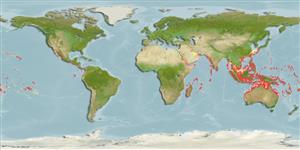Preferred temperature (Ref.
123201): 24.5 - 29, mean 27.9 °C (based on 652 cells).
Phylogenetic diversity index (Ref.
82804): PD
50 = 0.5005 [Uniqueness, from 0.5 = low to 2.0 = high].
Bayesian length-weight: a=0.01995 (0.00906 - 0.04395), b=3.01 (2.83 - 3.19), in cm total length, based on all LWR estimates for this body shape (Ref.
93245).
Nivel trófico (Ref.
69278): 4.2 ±0.73 se; based on food items.
Resiliencia (Ref.
120179): Alto, población duplicada en un tiempo mínimo inferior a 15 meses (Fec assumed to be > 10,000).
Fishing Vulnerability (Ref.
59153): Low to moderate vulnerability (35 of 100).
Nutrients (Ref.
124155): Calcium = 35.3 [17.9, 59.7] mg/100g; Iron = 0.568 [0.304, 0.993] mg/100g; Protein = 19 [17, 22] %; Omega3 = 0.105 [0.040, 0.254] g/100g; Selenium = 34.5 [16.4, 78.0] μg/100g; VitaminA = 101 [26, 373] μg/100g; Zinc = 0.82 [0.53, 1.24] mg/100g (wet weight);
